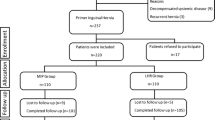Summary
The totally extraperitoneal placement (TEP) of a preperitoneal mesh for the repair of primary groin hernia is a well-accepted treatment. Recently a different way to place the preperitoneal mesh has been described, the grid-iron (Ugahary) approach. So far there has been no information about the surgical aspects of this operation and therefore this technique was compared to the TEP procedure in a randomized clinical trial. 162 patients were randomly allocated to have their unilateral primary groin hernia repaired by either a TEP or a grid-iron procedure. Complications during the operations and in the early postoperative period were investigated. The grid-iron approach appeared to be significantly shorter (27 minutes versus 39 minutes). Perioperative complications like bleeding from the epigastric vessels or peritoneal tears in the grid-iron group could be handled through the same incision, while in the TEP group conversion to an open anterior approach was necessary in six cases. It is concluded that the grid-iron approach for the repair of primary unilateral groin hernias is significantly faster, and that perioperative complications are easier too handle via the same incision.
Similar content being viewed by others
References
Arregui ME, Davis C, Yucel O, Nagan RF (1992) Laparoscopic mesh repair of indirect inguinal hernia using a preperitoneal approach: a preliminary report. Surg Laparosc Endosc 2: 53–8
Bilzer EM, Döming H, Schwartz FW (2000) Der Erfolg von Leistenbruchoperationen in der Routineversorgung aus der Sicht der Patienten. Chirurg 71: 829–34
Bower S, Moore BB, Weiss SM (1996) Neuralgia after inguinal hernia repair. Am J Surg 62: 664–7
Felix El, Michas CA, Gonzalez MM (1995) Laparoscopic herniaplasty: TAPP vs TEP. Surg Endos 9: 984–89
Kald A, Nilsson E, Anderberg B, et al. (1998) Reoperation as Surrogate Endpoint in Hernia Surgery. EurJ Surg 164: 45–50
Khoury NA (1995) A comparative study of laparoscopic extraperitoneal and transabdominal preperitoneal herniorrhaphy. J Laparoendosc Surg 5: 349–55
Klosterhalfen B, Klinge U, Hermanns B, Schumpelick V (2000) Pathologie traditioneller chirurgischer Netze zur Hernienreparation nach Langzeitimplantation im Menschen. Chirurg 71: 43–51
Kux M, in Hernien Operationen, M. Kux 1997 Johann Ambrosius Bart Heidelberg pp 133–142
Liem MSL, van Steensel CJ, Boelhouwer RU, et al. (1996) The learning curve for totally extraperitoneal laparoscopic inguinal hernia repair. Am J Surg 171: 281–5
Liem MSL, van der Graaf Y, van Steensel CJ (1997) Comparison of conventional anterior surgery and laparoscopic surgery for inguinal hernia repair. N Engl J Med 336: 1541–47
Stoppa RE, Warlaumont CR (1989) The peritoneal approach and prosthetic repair of groin hernia. In Nyhus LM, Condon RE eds. Hernia Philadelphia: J.B. Lippincott: 199–225
Ugahary F, Simmermacher RKJ (1998) Groin hernia repair via a grid-iron incision: an alternative technique for preperitoneal mesh insertion. Hernia 2: 123–5
Author information
Authors and Affiliations
Corresponding author
Rights and permissions
About this article
Cite this article
Simmermacher, R.K.J., van Duyn, E.B., Devers, G.J. et al. Preperitoneal mesh in groin hernia surgery. A randomized clinical trial emphasizing the surgical aspects of preperitoneal placement via a laparoscopic (TEP) or Grid-iron (Ugahary) approach. Hernia 4, 296–298 (2000). https://doi.org/10.1007/BF01201088
Received:
Accepted:
Issue Date:
DOI: https://doi.org/10.1007/BF01201088



